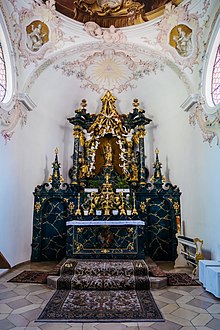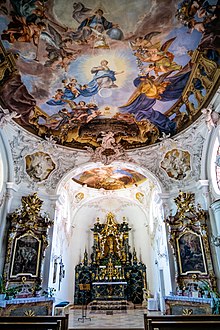Our Lady Chapel (Haunstetten)
The Mother of God Chapel is in the foreign cemetery in Haunstetten , a district of Augsburg ( Bavaria ).
history
Haunstetten belonged to the Benedictine monastery of Ortisei and Afra in Augsburg . In 1606, on the occasion of the founding of the Haunstetter Brotherhood of St. Corpus Christi built by Abbot Johannes Merk von Ortisei and Afra as a cemetery chapel. The then popular brotherhood had, among other things, the task of looking after people who died in Haunstetten and had no right of home , e.g. B. Servants to take care of. The current building, which was necessary because of the poor state of construction, goes back to Abbot Cölestin Mayr von Ortisei and Afra in 1740/41. The construction management was probably carried out by the Augsburg builder Johann Paulus. Today the chapel is known as the "Pearl of the Rococo " in the Augsburg area.
Pilgrimage
In 1626, Karl Stengel, Benedictine monk of Ortisei and Afra, donated an altar and, with the abbot's permission, erected a Gothic wooden statue of the Virgin Mary venerated as a miraculous image ( high altar ). This became a popular pilgrimage destination . In addition to Maria, the farmer saints Leonhard and Wendelin were venerated.
Interior
The frescoes are by Christoph Thomas Scheffler . Its main sphere of activity was the Bavarian-Swabian region. Abbot Cölestin Mayr was Scheffler's most important sponsor and commissioned him in 1742 to paint the Chapel of Our Lady.
The stucco work was carried out by Ignaz Finsterwalder from 1742 . He mostly worked as a plasterer together with his older brother Johann (I) Baptist. Other works include the stuccoing of the parish churches of Bertoldshofen (1730–33), Westendorf (1740) and Denklingen (1765/66). The interior of the current building was completed in 1752.
Ceiling painting in the nave
The ceiling paintings in the nave serve to glorify Mary , whose veneration was a special concern of the Benedictines . The large painting is about the victory of the apocalyptic woman over the dragon. According to the Revelation of John ( Rev 12,1 EU ) it shows “A woman clothed in the sun; the moon was under her feet and a wreath of 12 stars on her head. ”the end-time battle between the diabolical and divine powers. The fresco is therefore divided into two parts, whose people are hostile to each other: the heavenly inhabitants with Mary in their midst and the powers of darkness with Satan at the head. Mary is connected to the Trinity above her through a ray of grace . In the midst of the diverging worlds, an angel proclaims the victory of God's people. The small paintings in the spandrels show the extraordinary position of Mary in the divine plan of salvation: God the Father with Mary as a child (Jdt 8,1), Mary as the mother of Christ (Mt 1,18), Mary as the bride (Song of Songs 4), Mary and the Trinity (Sir 43.4).
Frescoes in the choir
The main fresco in the choir shows, based on Est 2.17 ("He put the royal diadem on her and made her queen."), The coronation of Mary by Christ. The four cardinal virtues justice, strength, wisdom and temperance are symbolized by female figures in the spandrels .
After secularization
When the imperial monastery St. Ulrich and Afra was abolished due to the secularization in Bavaria in 1802/03 , the chapel became the property of the Bavarian state. The pilgrimage ended. When the church was threatened with demolition, it was bought by the Haunstetten community between 1813 and 1840. In 1858 the onion of the gable rider was replaced by a pointed helmet . From 1945 to 1949 the chapel served as a place of worship for Baltic Displaced Persons (DPs), mainly Lithuanians. A stone tablet inside reminds of this. In 1953 the ridge turret was erected again according to the old model. In 1972 the chapel became the property of the city of Augsburg when it was incorporated . Numerous interior and exterior renovations followed. The chapel is registered on the Bavarian list of monuments.
The Mother of God Chapel is now looked after by the Catholic parish of St. Georg Haunstetten and serves, among other things, as a popular wedding chapel.
Outdoor area
The grave of an unknown fallen soldier commemorates the victims of World War II .
literature
- Thomas Balk: The Augsburg history painter Christoph Thomas Scheffler , DKV-Kunstführer 537/9, 1st edition Munich / Berlin no year.
Web links
Individual evidence
Coordinates: 48 ° 18 ′ 42.5 " N , 10 ° 54 ′ 37.8" E



